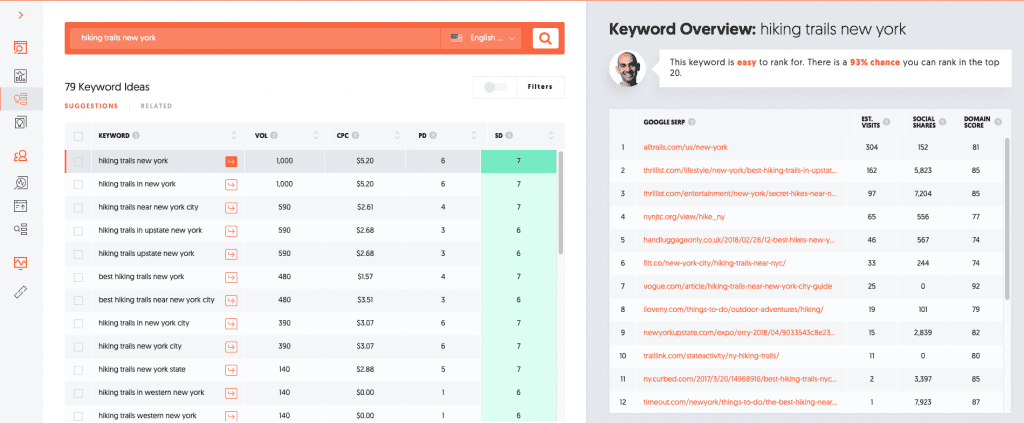When I started writing content ten years ago, this type of sentence was the standard: “Splash Down water park is one of many things to do Poughkeepsie NY.” Sometimes we’d spell “Poughkeepsie” wrong to account for typos. Writers would include “things to do Poughkeepsie NY” 10x in a 300-word article – keyword stuffing was encouraged. Marketers didn’t care about improper English; they cared that people were searching for exactly that, and Google needed to find it.
As Google progressed, so did (most) marketers and content writers. Today, you barely have to think about SEO when crafting an article. If you’re a solid writer and you’re staying on-topic, it tends to get in there naturally.
Google has also gotten awesome at reading and analyzing texts. It’s like it went from kindergarten to college-level in the last decade. If you want to optimize for “hiking trails in New York,” it knows that “hiking trails in NY” and “hikes in New York” are the same thing. You no longer have to match keywords word-for-word – and you shouldn’t, because that can result in low-quality articles, which Google doesn’t like.
What is Keyword Stemming?
Keyword stemming is Google’s ability to understand various forms of a keyword or phrase. It takes the root word (the stem) and figures out variations that deliver the same information. If the stem is “run,” variations that Google recognizes are ran and running. If the stem is “search,” variations are searching, searched, searches and searchable. Google picks up on the variations along with the stem word.
Stemming isn’t new to Google. It was around ten years ago when I was still writing about “things to do Poughkeepsie NY” (ugh, terrible – here’s how to really do local SEO). Google wasn’t nearly as great as recognizing word variations, though, which is why stemming wasn’t the standard back then. Today, there are still some marketers who want those awful, unnatural word-for-word matches. Don’t do it – it’s completely outdated, along with keyword stuffing.
Finding Keyword Variations
I’m biased, but my suggestion is to hire a professional with experience writing SEO-optimized content. For many of us, it’s second nature to write variations of stem words, and I can easily spot a sentence to tweak for optimization. For example, let’s take that last sentence and optimize it for “keyword stemming” – For many of us, keyword stemming is second nature, and I can easily spot a sentence to tweak for optimization.
That said, there are a lot of tools that can help you figure out keyword variations. This is a little different from doing straightforward SEO research. You already know the keyword or phrase you want to optimize for, you just need to find variations of it. These tools will help you create a list of variations. However, the best thing to do is to train yourself to think in keyword variations so it becomes natural.
I purposely left off Ahrefs because we have a big ‘ol guide right here.
I always prefer the simpler, homegrown solution. My go-to is Google itself. You don’t necessarily want to look at the auto-populated search suggestions, though. For “hiking in New York,” this is what comes up:

Nothing I don’t already know. When I click on a search result and scroll to the bottom, I get helpful suggestions like “NY hiking trails” and “hiking near NYC.”

Karooya
The simplest keyword variation tool is from Karooya. It’s a stripped down search tool that gives you straightforward variations, nothing more. Use it if your brain is stuck and you can’t think of common forms of single words.

SEMrush
The Keyword Magic Tool from SEMrush lets you enter a seed keyword (the stem) and generate more keyword ideas. I entered “hiking in New York” and selected “Broad Match,” which gives any variation of the phrase in any order. Here are the results:

Several of the variations still have “hiking in New York” written exactly like that, and I already know I can use that phrase as-is. What’s helpful are the suggestions for “places to hike in New York,” “best hikes in New York State” and “top hiking trails in New York.”
Ubersuggest
Neil Patel’s browser-based app Ubersuggest can give you keyword ideas from a stem word or phrase, and also tell you your chances of ranking for the keyword, plus the top search engine results.

Keyword Stemming and Yoast SEO
How do you know if you’re handling keyword stemming right before you publish a piece of content? Plugins like Yoast – which we use at Elegant Themes – tell you if you’re hitting the mark when it comes to SEO (and its criteria goes far beyond keywords).

When they released Yoast SEO 9.0 in October 2018, they announced, “As of today, Yoast SEO does recognize those keyphrases when they are spread out over a sentence. Even if you put some extra words in between. And the words don’t even have to be in the same order!” That means that Yoast can recognize “New York hiking trails” as well as “New York’s best hiking trails” as the same keyword. They also announced that Yoast SEO Premium supports word forms, which is their term for keyword stemming.
Quickly Updating Your Content for Optimization
If your content isn’t optimized according to Yoast, there’s a quick way to optimize. Seek out partial keyword phrases and update the sentence to maximize the SEO possibilities. For example, if I want to rank for “keyword stemming” in this article but Yoast is telling me I’m not there yet, I would search for “stemming” to find sentences where I didn’t use the full phrase. I quickly found one: “Stemming isn’t new to Google.” I’d just add “keyword” to the beginning of the sentence and boom, a bit more optimization without unnatural use or stuffing.
Also, I know this is getting kind of meta but look at that last paragraph again. I didn’t take every single opportunity to use the full phrases, because that would be stuffing and the sentences wouldn’t flow as well.
Here’s another example. Let’s say I want to optimize for “biking in New York City.” My original sentence is, “The best biking routes run along the river.” I can change it to any of these options:
- The best biking in New York City is along the river.
- New York City biking is prettiest along the river at sunrise.
- Check out these riverside biking routes in New York City.
I’ve optimized for my keyword and can also experiment with stemming if variations fit better.
When Not to Use Keyword Stemming
Overusing or misusing keyword stemming creates low-quality content that tries to trick Google and disappoints readers. Here are two examples:
- If I want to rank for “hiking in New York,” Google may recognize “hiker in New York,” but that’s not the context of my article. I’m not covering hikers, I’m covering hiking trails. This variation doesn’t fit the context of my article, and it may seem like a bait-and-switch.
- “Hiking in NYC” may be a Google-friendly variation to “hiking in NY,” but it’s changed the stem word too much (and it’s out of context).
Don’t use keyword stemming if it doesn’t fit the context or if the variation is unrelated to the stem word.
Final Thoughts
It’s important to know what Google hates because it replicates what users hate. Google serves the user, and its algorithm changes usually revolve around creating a better user experience. In a way, it’s like Google has done some audience research for you.
Google doesn’t like clumsy wording or anything that makes content seem engineered. Keyword stemming gives you the ability to include plenty of SEO while mixing up wording and focusing on writing quality.
Want to learn more about how Google ranks your web pages? Check out our Beginner’s Guide to Google’s 4 Most-Important Ranking Algorithms.
The post A Marketer’s Guide to Keyword Stemming (and Not Keyword Stuffing) appeared first on Elegant Themes Blog.
